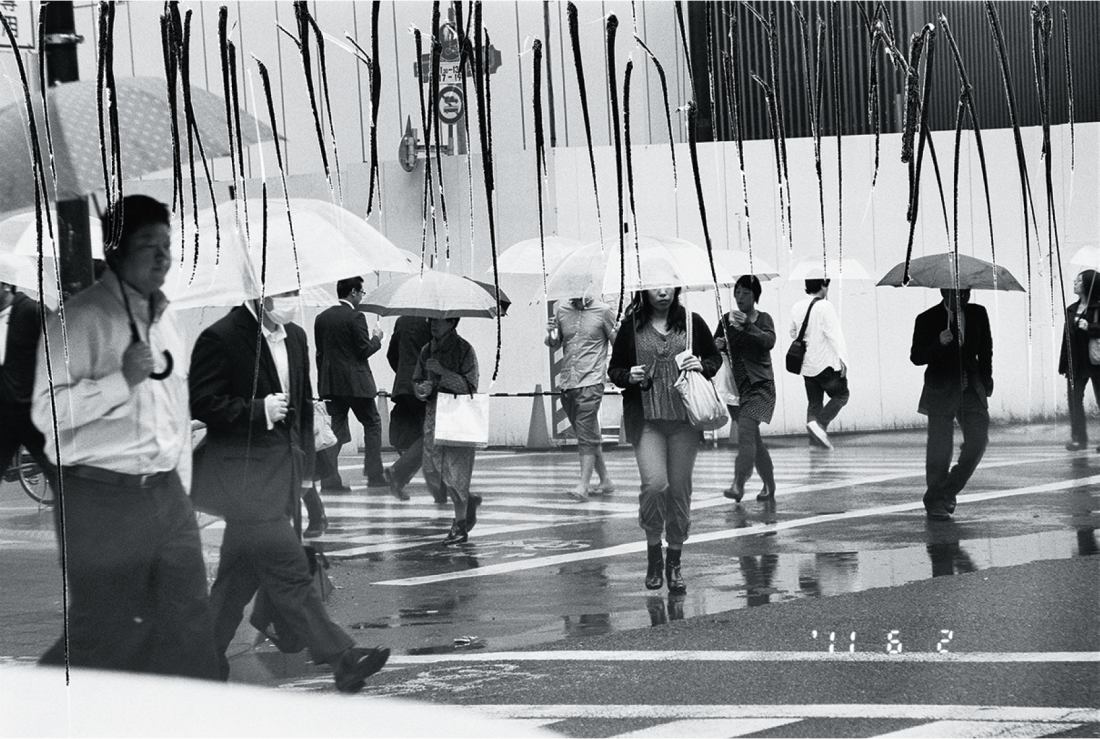“In the Wake: Japanese Photographers Respond to 3/11”
I am standing in this beautiful museum, home to the world’s largest collection of Japanese art outside of Japan. Before me is Hokusai’s The Great Wave, 1831–32: a metonym for “Japanese art” and an icon in the public imagining of tidal waves (a fact that will soon become significant). I have seen the print in reproduction so often, memorized its particular Prussian blue and the slant of its imperiled boats, and always assumed it to be as large as the massive force it depicts. In actuality, it is very intimate—roughly 10 x 15 inches—almost disappointingly tiny.
I move through the jostling crowd to a comparatively quieter corner of the museum. The show I have come to Boston to see, “In the Wake,” commemorates the 2011 Great East Japan earthquake, tsunami and nuclear meltdown. It is the first in North America or Japan to explore the photographic response to the “3/11” disasters.
Careful, elegant, composed are words that immediately spring to mind as I enter the gallery. Decorous, understated. There are no bodies to be seen here, no visible wounds. The curatorial selections veer away from the tragic and spectacular image towards the metaphoric and the oblique.
What might constitute a suitable response to the disasters aligns itself with a tasteful minimalism in Takashi Homma’s Mushrooms from the Forest, 2011. Radioactive mushrooms from a forest near the Fukushima plant are shown against a sterile white field. They are dangerously and distractingly beautiful. I know I am meant to be considering the disparity between their lovely outward appearance and their terrible inner toxicity but the surfaces are so beguiling they remind me of images in a Donna Hay cookbook.

Takashi Homma, “Mushrooms from the Forest,” 2011, photograph, pigment-based inkjet print. © Takashi Homma. Courtesy Museum of Fine Arts, Boston.
Others works by Daisuke Yokota, Masato Seto and Kikuji Kawada, while sounding the limits of representation, feel a bit too formally on-the-nose, employing techniques of tonal reversal or intense colour contrast to represent an irradiated world. More subtle, Shimpei Takeda’s 2012 series “Trace” makes use of a cameraless photographic technique known as “autoradiography” to expose spaces around Fukushima that have been affected by radiation. The results are visually arresting images of irradiated soil that recall galaxies and stars in the cosmos.
The most viscerally affecting work is Nobuyoshi Araki’s Diary of a Photo-Mad Old Man, 2011. In his grief and anger, Araki took scissors to photographic negatives he shot on and around 3/11—including street scenes and sky shots—to create violently gouged and disfigured prints.
Araki’s evocation of atomic “black rain” (in a scissor-marred portrait of umbrella toting pedestrians) calls forth a dominant theme in the show: the spectre of Hiroshima and Nagasaki. Tomoko Yoneda’s Cumulus, 2011, extends the theme by juxtaposing images of contemporary Hiroshima and Fukushima with symbols of im perialist Japan to ask how bowing to authority paved the way for what scholar Akira Mizuta Lippit calls the “unthinkable return of radiation.”
Yoneda’s images (which move beyond static remembrance to a dialectical reckoning with Japan’s past) will stay with me long after I leave the museum. So will photos from the “Lost and Found” project, a series of ghostly, damaged family snapshots salvaged after the tsunami and earthquake. (Tokyo artist Munemasa Takahashi worked with volunteers from across the country to recover and restore nearly 750,000 photographs. Many were repatriated but a vast number, including the approximately 200 photos displayed here, remain orphaned.)

Nobuyoshi Araki, “Shakyō rōjin nikki” (“Diary of a Photo-Mad Old Man”), 2011, gelatin silver print. © Nobuyoshi Araki. Courtesy Taka Ishii Gallery, Tokyo, and Museum of Fine Arts, Boston.
It is not that the other works are lacking on their own terms. But the overall atmosphere of refinement and restraint (while offering a reflective contrast to the storm of news images that surrounded 3/11) feels a bit too smooth and uniform. I cannot shake the feeling that many of the images risk being absorbed within the decorative and decorous visual grammar pervading the rest of the museum’s collection of Japanese art. (A reminder that what might possess potency when encountered individually is sometimes blunted en masse.) The risk of showing art with such a lovely, high-technical finish is that it places what is already geographically and digestibly distant in an even more remote frame—verging on what the historian Edward T Linenthal has termed the “comfortable horrible.”
It is interesting to note, then, that the exhibition’s main draw is not the art at all but rather the real-time video footage from March 11 playing on a monitor in the back of the gallery. The small room is crowded with people when I visit, hungry for the seeming artlessness of the news camera, raptly watching as a thick black wave obliterates everything from roads to houses in its path.
This room feels like a rebuttal, a swerving away from the low-key conceptualism of the main room. It offers a needful reminder that the tsunami didn’t look like Hokusai’s The Great Wave. It was not, as curators Anne Nishimura Morse and Anne Havinga emphasized to me, “a beautiful cresting thing.”
The curators, alert to the issues raised by creating art from such harrowing events, invite us to shuttle between the two conflicting spaces, recognizing that neither alone can stand for 3/11 and its aftermath. Any reconciliation between the elegantly composed gallery and the anarchic mediated world remains impossible. As WG Sebald writes, “The issue, then, is not to resolve but to reveal the conflict.” ❚
“In the Wake: Japanese Photographers Respond to 3/11” was exhibited at the Museum of Fine Arts, Boston, from April 5 to July 12, 2015.
Kyo Maclear is a Toronto-based essayist, novelist and children’s author. She is a PhD student in York University’s Faculty of Education.

